Nana’s Italian Easter Bread
This traditional Italian Easter Bread, also known as Pane di Pasqua, is an old family recipe; it's a rich brioche-style dough that is flavored with orange and anise, brushed with icing, and decorated with sprinkles. This colorful holiday bread is a wonderful addition to Easter brunch or to enjoy on the days leading up to Easter!
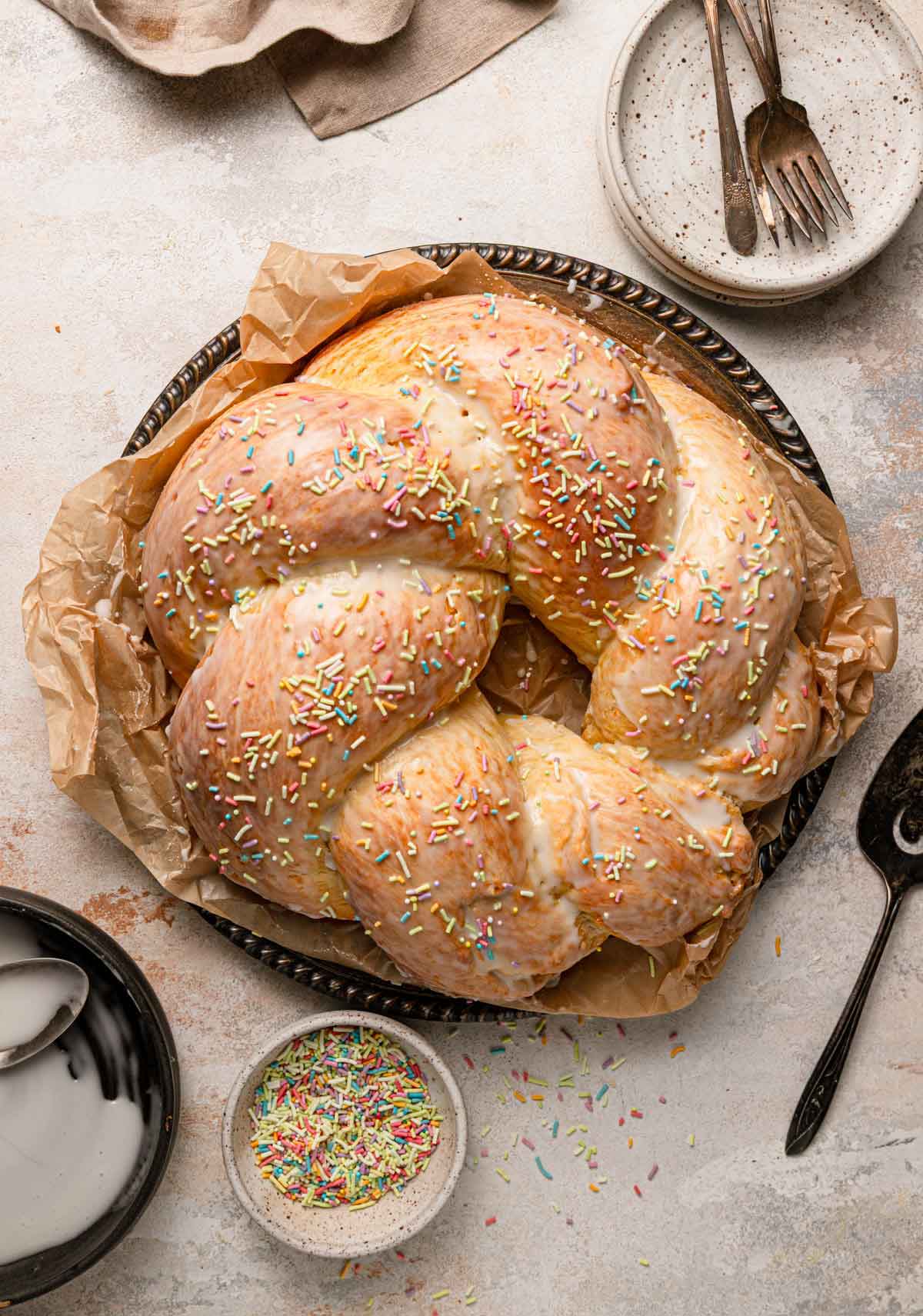
Years ago, when my husband and I began dating, my father-in-law talked often about his Nana's Easter bread, with orange and anise, and it seemed inconceivable that my grandma had never made it, but I had definitely never eaten it.
It's a fabulous bread - a rich and slightly sweet bread, but light and fluffy, and is flavored with orange and anise. He was generous enough to share his family's recipe with me so that I could make it on my own and share it with all of you.
When I shared this bread with my mom, she said that my grandma did, indeed, make this exact bread, and even remembered that she would set dyed eggs in the dough. However, she said my grandfather was the only one in the family who ate the bread, so my grandma stopped making it when he passed away.
I was disappointed that I had never been introduced to it before, but thrilled to know that it had been a part of my family's tradition at some point, and that it was something my grandpap loved.
A Little More History
I did some reading up on Italian Easter Bread recipes before tackling this one for the first time, and found that most are flavored with citrus (orange or lemon) and anise oil and/or anise seeds.
The bread is shaped like a wreath to symbolize the crown of thorns.
Usually, the loaves are braided and have a dyed egg nestled into the braids in various spots. I skipped the Easter eggs, but went the traditional route with braided loaves, sweet glaze, and sprinkles (because, of course).
Key Ingredients & Notes
While you will use some basic ingredients like flour, sugar, eggs, and salt, there are a few other things you’ll need that are what make this the incredible bread it is:
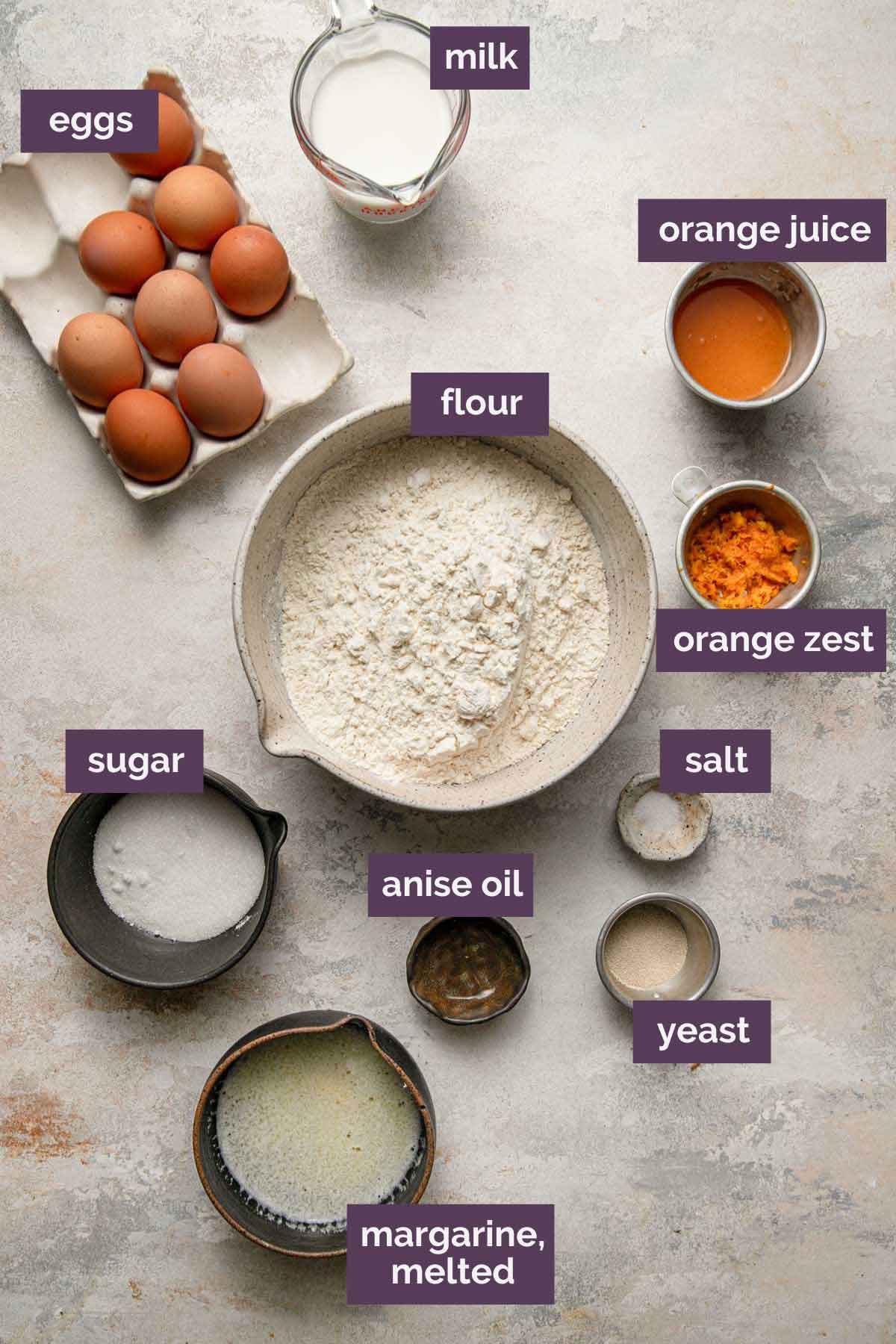
- Milk – I encourage you to use whole milk for the richest bread, but you can substitute 2% if needed.
- Oranges – You will use the juice and zest from two oranges. I use this microplane for zesting citrus, and this simple juicer for extracting juice (it catches the pulp and seeds!). If you want to change up the flavor, you can use lemon zest and lemon juice.
- Active Dry Yeast – You can substitute instant yeast without making any other modifications to the recipe.
- Margarine – The original recipe calls for margarine, but you can substitute unsalted butter.
- Anise Oil – If you can only find anise extract, use 2 teaspoons, as it is not as concentrated as anise oil.
While the colored eggs are a traditional touch, if you don’t usually dye Easter eggs, don’t worry, the bread is just as delicious without! Our family typically does not include them.
How to Make Italian Easter Bread
This is a traditional two-rise bread recipe. I typically mix it in a bowl with a wooden spoon and knead by hand, but you can absolutely use a stand mixer with a dough hook attachment if you’d like.
Step 1: Make the Dough – Rub together the sugar and orange zest until the sugar is completely moistened, then stir in the warm milk to dissolve the sugar, then stir in the yeast and let sit for 10 minutes. Add this mixture to the flour and stir, then stir in the margarine and orange juice. In a separate small bowl, stir together the eggs, anise oil, and salt, and add to the dough. Add more flour if needed.
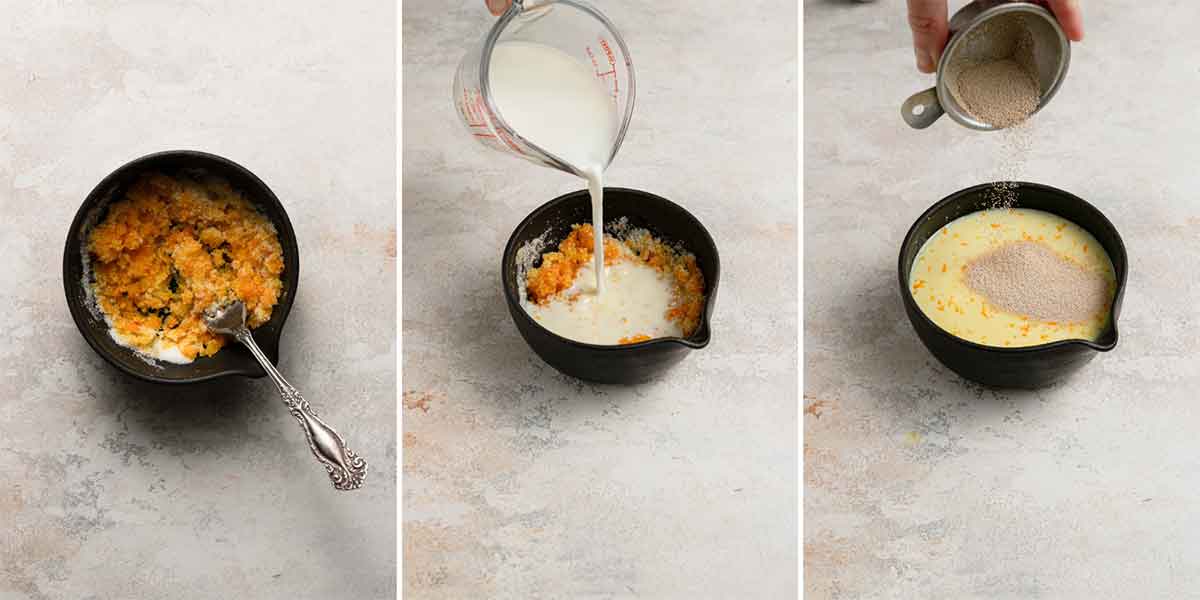
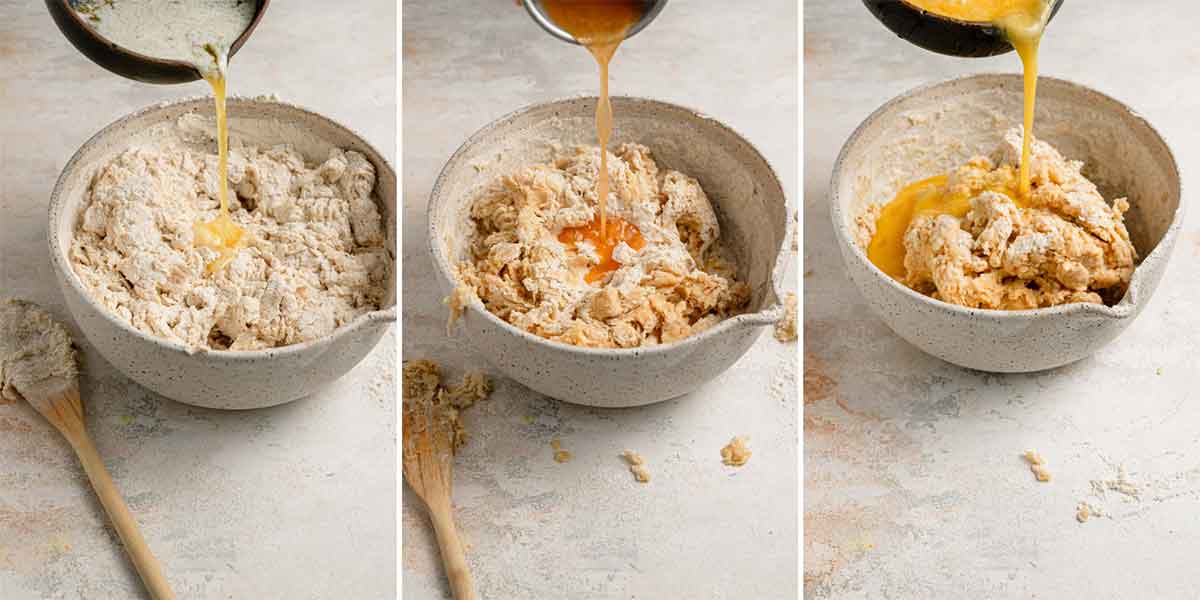
Step 2: Knead the Dough – Once a sticky ball of dough has formed, turn it onto a floured surface and knead, adding a little more flour at a time if needed, until a smooth and elastic ball has formed, about 5 minutes.
Step 3: First Rise – Place the dough in an oiled bowl, turn to coat, then cover loosely with plastic wrap and place in a warm, draft-free spot until doubled in size, about 1 hour.
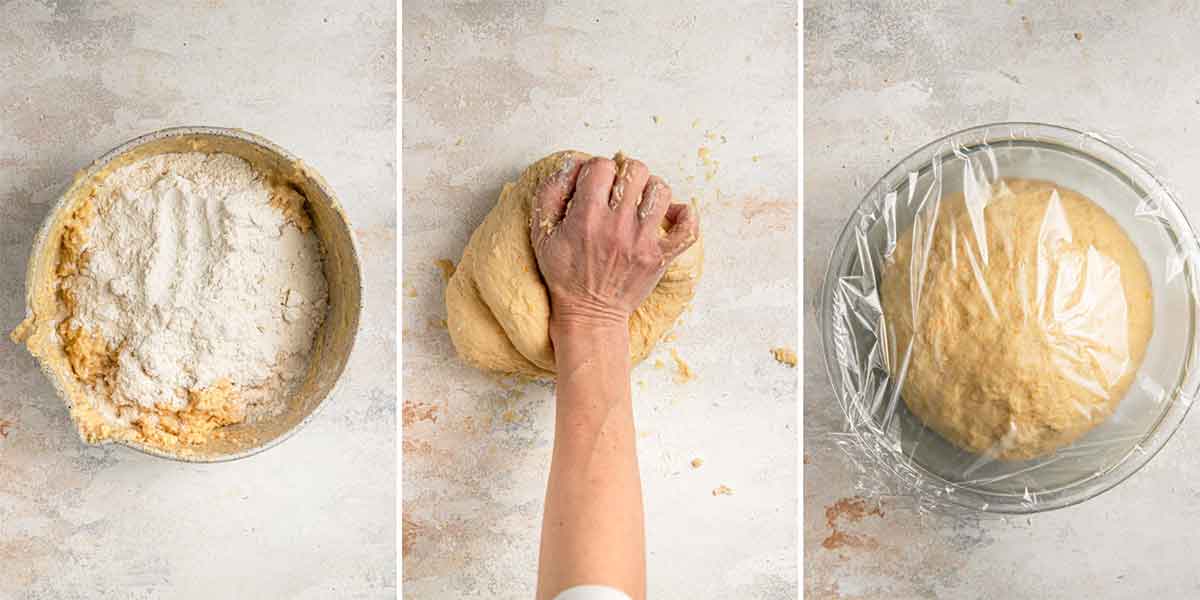
Step 4: Shape the Bread – This recipe makes two loaves of bread, so you will divide the dough into four and work with two pieces at a time. Roll them into 24-inch ropes, then loosely twist them together, bring the ends together, then transfer to a parchment-lined baking sheet. Twist and pinch the ends together to seal shut. Repeat with the remaining two pieces of dough to create the second loaf of bread.
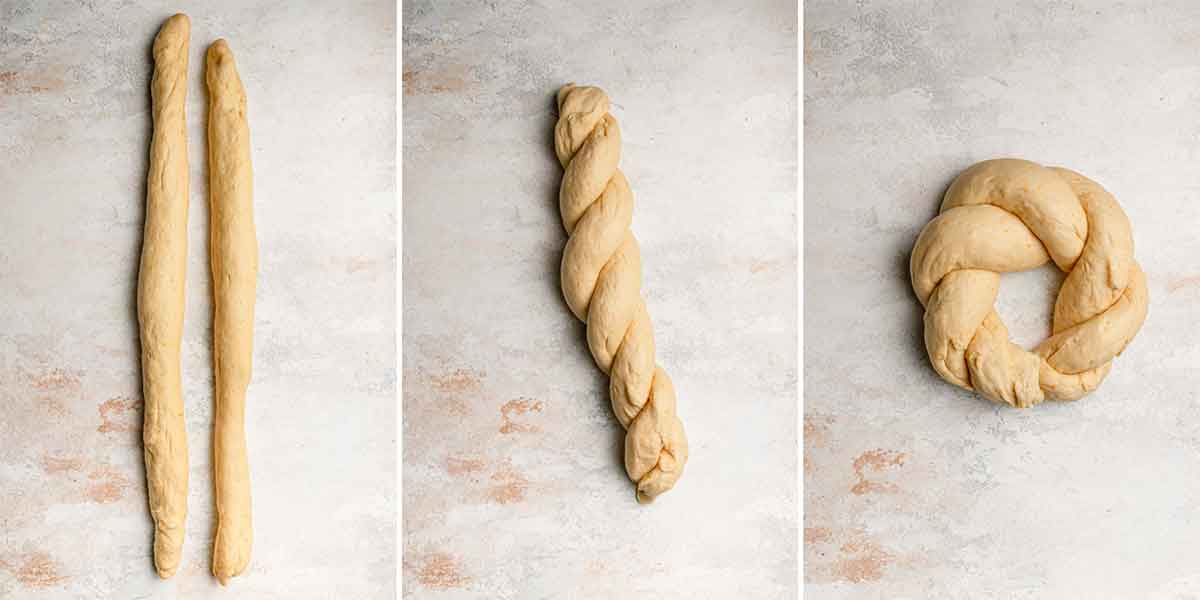
Step 5: Second Rise – Brush the loaves of bread with melted butter, cover loosely with plastic wrap, and let rise until nearly doubled in size, about 45 minutes to hour.
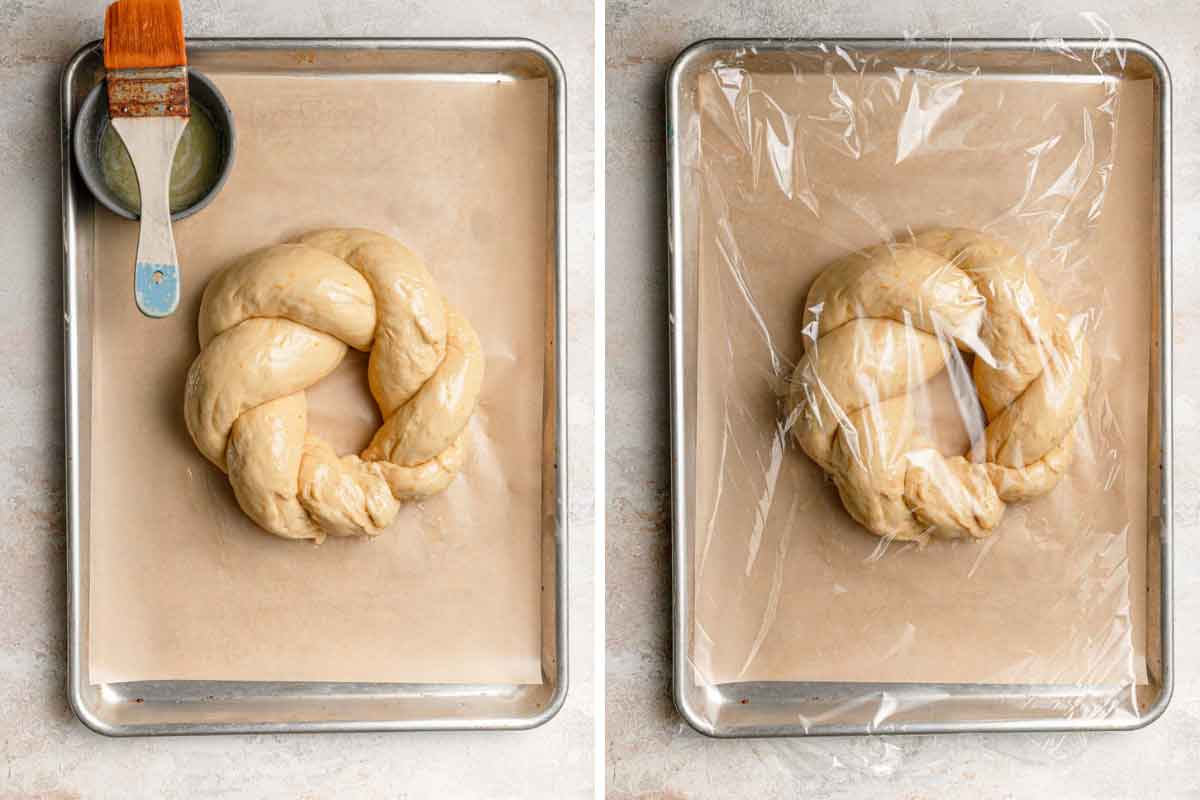
Step 6: Bake and Glaze – Bake the loaves one at a time at 350 degrees F until golden brown, about 30 to 40 minutes. Cool completely on a wire rack, then whisk together the powdered sugar and milk and brush the glaze mixture over the loaves, then add sprinkles.
Storage and Freezing Instructions
Any leftover bread should be wrapped tightly in plastic wrap (and placed in a ziploc bag if you want extra assurance to keep it fresh) and kept at room temperature for up to 3 days. You can eat it room temperature or even toast it and add jam for breakfast!
To freeze the bread, wrap either an entire loaf or individual slices tightly in plastic wrap. If freezing a whole loaf, wrap again in aluminum foil. Place the loaf of the slices in a freezer bag and store in the freezer for up to 3 months. Individual slices will thaw easily at room temperature; I recommend moving a whole loaf to the refrigerator to thaw a day in advance of serving.
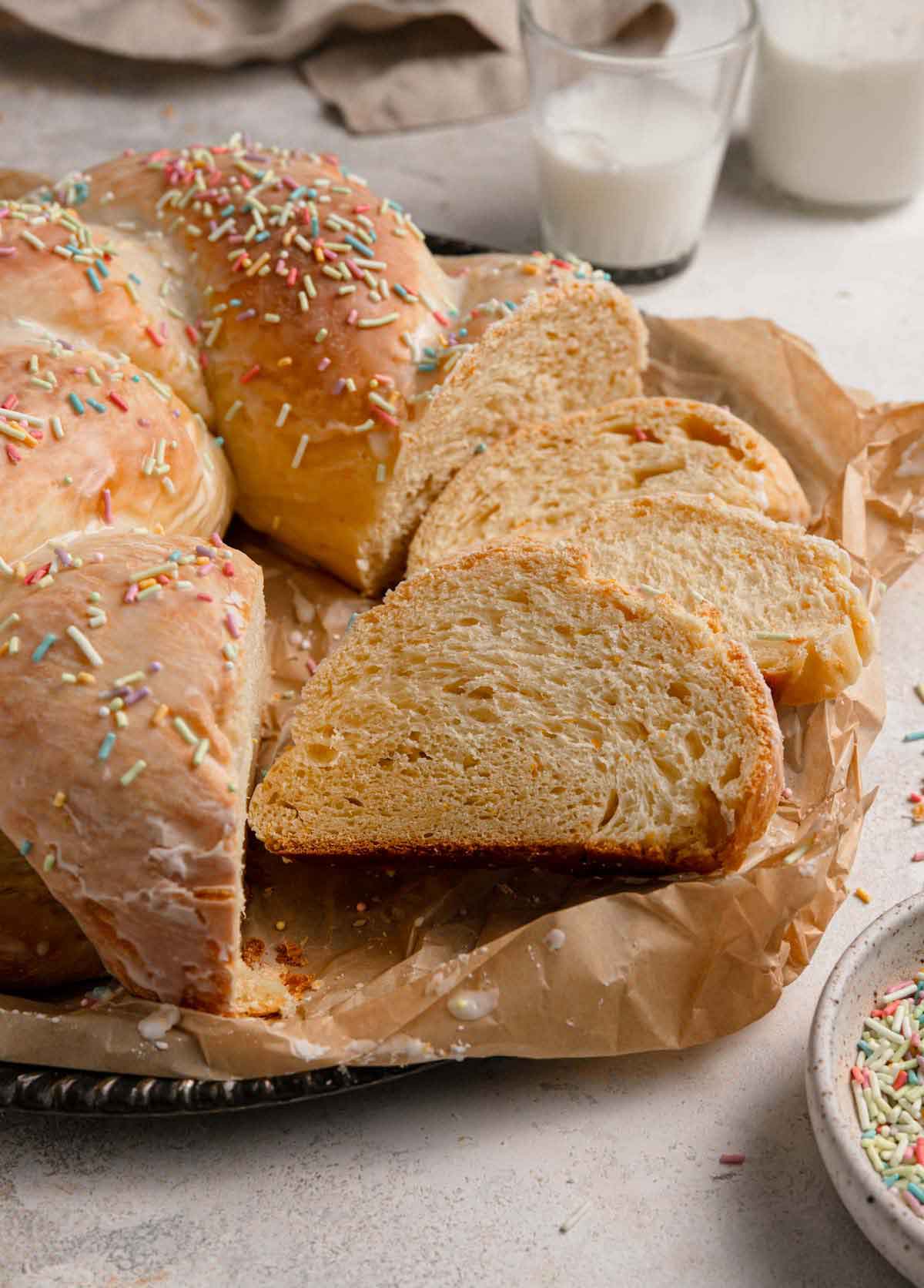
Watch the Italian Easter Bread Recipe Video:
More Easter Breads
- Paska (Polish Easter Bread)
- Greek Easter Bread (Tsoureki)
- Hot Cross Buns
- Grandma’s Bacon and Cheese Easter Bread
If you make this Italian Easter bread recipe and love it, remember to stop back and give the recipe a 5-star rating - it helps others find the recipe! ❤️️
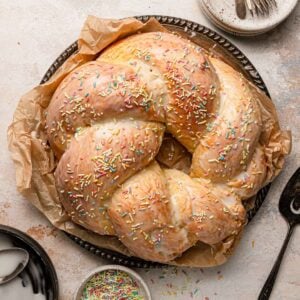
Italian Easter Bread Recipe
Ingredients
For the Dough
- 8 cups (1040 g) all-purpose flour
- 1½ cups (360 ml) whole milk
- ½ cup (99 g) granulated sugar
- 2 oranges, zested & juiced
- 4½ teaspoons (2 envelopes) active dry yeast
- 1 cup (227 g) margarine, melted
- 8 eggs
- 1 teaspoon salt
- ½ teaspoon anise oil
- 2 tablespoons unsalted butter, melted (for brushing)
For the Glaze
- 2 cups (227 g) powdered sugar
- ¼ cup (60 ml) whole milk
- Sprinkles, if desired
Instructions
- Make the Dough: Place the flour in a large mixing bowl; set aside.
- Heat the milk in a small saucepan over low heat, stirring occasionally, until it is warm to the touch, but not hot. If you have an instant-read thermometer, the temperature of the milk should be between 110 and 115 degrees F.
- While the milk is warming, place the sugar in a small bowl and add the orange zest. With your fingertips, rub the zest into the sugar until it is completely incorporated and the sugar is moistened.
- Once the milk reaches the correct temperature, stir in the sugar and zest mixture, stirring to dissolve the sugar. Add the yeast, stir, and let sit for 10 minutes.
- Add the milk and yeast mixture to the flour and begin to mix it into a dough (it will be shaggy at this point).
- Next, add the melted margarine and continue to mix. Then, add the orange juice to the dough and mix to combine.
- In a small bowl, use a fork to lightly beat together the eggs, salt, and anise oil. Add to the dough and continue mixing.
- At this point, you may need to add more flour to the dough, depending on how much juice you get out of your oranges. (I added quite a bit more to get the dough to come together.) Once you have a sticky ball of dough formed, turn it out onto a floured surface and knead for about 5 minutes, adding a small amount of flour at a time as needed, or until the dough is soft and elastic. It will remain slightly tacky.
- Place the dough in an oiled bowl, turning to coat, and cover the bowl loosely with plastic wrap. Place in a draft-free area and allow to rise until doubled in volume, about 1 hour. Meanwhile, line two baking sheets with parchment paper and set aside.
- Shape the Bread: Turn the dough out onto a clean surface and divide in two. Divide each half into two (you will have four pieces of dough). We will work with one pair, and then the other. Roll two pieces of dough into 24-inch long ropes. Loosely twist the ropes together. Transfer the braided rope to one of the prepared baking sheets and bring the ends together to form a ring, twisting and pinching the ends together to seal. Repeat with the remaining two pieces of dough so that you have two circular, braided loaves. Brush the tops of each with the melted butter, loosely cover with plastic wrap, and let rise until nearly doubled in size, about 45 minutes to 1 hour.
- While the dough is rising, preheat the oven to 350 degrees F. Bake one at a time (unless you have the oven capacity to correctly bake both at the same time) until golden brown on top, 30 to 40 minutes. Remove from the oven and transfer to a cooling rack to cool completely.
- Glaze the Bread: Once the breads are cooled to room temperature, you can glaze them (if you desire). In a small bowl, whisk together the powdered sugar and the milk until smooth. Use a pastry brush to brush the glaze onto the top and sides of the bread, and decorate with sprinkles. The bread is best served at room temperature. If you have leftovers, wrap well in plastic wrap and store at room temperature for up to 3 days.
Notes
- Equipment – While I mix this by hand, you could certainly use a stand mixer fitted with a dough hook instead.
- Milk - I encourage you to use whole milk for the richest bread, but you can substitute 2% if needed.
- Oranges - You will use the juice and zest from two oranges. I use this microplane for zesting citrus, and this simple juicer for extracting juice (it catches the pulp and seeds!). If you want to change up the flavor, you can use lemon zest and lemon juice.
- Active Dry Yeast - You can substitute instant yeast without making any other modifications to the recipe.
- Margarine - The original recipe calls for margarine, but you can substitute unsalted butter.
- Anise Oil - If you can only find anise extract, use 2 teaspoons, as it is not as concentrated as anise oil.
- Scaling – If you wish to make only one loaf of bread, you can simply halve all ingredient quantities.
- Storage – Wrap leftover bread tightly in plastic wrap and store at room temperature for up to 3 days.
- Freezing Instructions – Wrap a whole loaf or individual slices in plastic wrap. If storing a whole loaf, wrap again in aluminum foil. Place the loaf of the slices in a freezer-safe ziploca bag and freeze for up to 3 months. Thaw a whole loaf in the refrigerator overnight; thaw individual slices at room temperature.
Did you make this recipe?
Leave a review below, then snap a picture and tag @thebrowneyedbaker on Instagram so I can see it!
Photography by Dee Frances


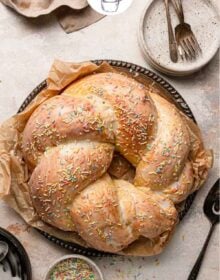



If you were to use eggs for decorating, would you use raw or boiled ?
Hello! I would use raw eggs.